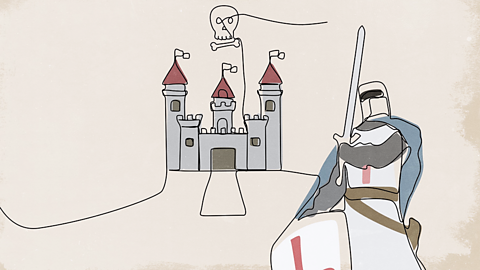Did you know?
The Mahabharata is the longest poem in the world with around 1.8 million words. Whilst the shortest poem in the world consists of just one letter!
Introduction to form in poetry
Poems come in all kinds of shapes and sizes. They are laid out and divided up carefully by the poet. When we look closely at a poem, its form and structure can give us clarity on the message and meaning of the poem.
Find out how to identify form in poetry
What is form?
The form of a poem is how we describe the overarching structure or pattern of the poem. Some forms of poetry must stick to very specific rules about length, rhythm and rhyme.
Poets enjoy playing with form. They often have fun making and breaking rules!
Identifying form in poetry
Looking at the layout of a poem and listening for sound patterns т particularly rhymeWhen words have the same sound e.g. cat/hat or line/sign. and rhythmCan be described as the beat and pace of a poem. Rhythm is created by the pattern of stressed and unstressed syllables in a line or verse. т helps to identify the form.
Stanzas separate poems into groups of lines.
One was of describing is stanzas is by saying how many lines it has:
- A tercet is a stanza that is three lines long
- A quatrain is four lines
- A quintrain is five lines
- A sestet is six
- A septet seven
- An octave or octet is т you guessed it т eight lines long
In his poem, The Eagle, Alfred, Lord Tennyson breaks his poem into two stanzas:
He clasps the crag with crooked hands;
Close to the sun in lonely lands,
Ringтd with the azure world, he stands.
The wrinkled sea beneath him crawls;
He watches from his mountain walls,
And like a thunderbolt he falls.
The first stanza describes the eagle perched high on the mountain and the second stanza describes it swooping down. Breaking the poem into two separate events helps to increase the drama.
The final word on each line within a stanza rhymes: hands/lands/stands and crawls/walls/falls. A rhyme scheme of AAA BBB.
Each line in the poem has eight syllables and it has a distinct rhythm, called iambic tetrameterA line of poetry with four beats of one unstressed syllable, followed by one stressed syllable. It sounds like: duh-DUH, duh-DUH, duh-DUH, duh-DUH., when you say it aloud.
Different forms of poetry
There are many different forms of poetry. Common poetry forms, such as the ballad, sonnet, haiku, limerick, ode, epic and acrostic, have specific rules.
An acrostic is a poem where the first letter of each line spells out a word, vertically.
A limerick is a funny five-line poem with a rhyme scheme AABBA.
A haiku has three lines, which in total make up 17 syllables - line one has five, line two has seven and line three has five.
A Shakespearian sonnet always has 14 lines. They all end with a rhyming couplet (two lines next to each other that rhyme) and the first 12 lines are divided into three quatrains, with rhymes on alternate lines. A sonnet follows the rhyme scheme ABAB CDCD EFEF GG.
Some poems deliberately donтt follow specific rules. Free verse has no rhyme or particular rhythm.
Traditional forms of poetry
Centuries ago, travelling poets shared tales and news in balladTypically composed of quatrains that follow a regular, rhyme scheme. There is often a refrain т a repeated line or stanza т like a chorus in a song. т ballads were easy to remember as they used quatrains and alternating rhyme schemes.
Poets performing at court created clever poems т like sestinaA sestina has six sestets each followed by a tercet; each line ends with one of six words that are later repeated in a fixed order. т to show off their word skills.
The villanelleA nineteen-line poem consisting of five tercets and a quatrain, with a very specific rhyme scheme. (invented in the sixteenth century) is another example of a poem that takes great technical skill to write.
One of the most famous modern villanelles by Welsh poet Dylan Thomas begins with this tercet:
Do not go gentle into that good night,
Old age should burn and rave at close of day;
Rage, rage against the dying of the light.
The first line and the third line then get repeated through the rest of the poem, carrying the poemтs key message of anger and defiance against death (тthe good nightт).
Looking at how form reflects theme
The poems form usually reflects what the poem is about. For example, a happy poem might have short, bouncy lines. In this extract from the poem Aliens Stole My Underpants, Brian Moses uses a catchy rhyme and beat to suggest a funny tale being told:
To understand the ways
of alien beings is hard,
and Iтve never worked it out
why they landed in my backyard.
And Iтve always wondered why
on their journey from the stars,
these aliens stole my underpants
and took them back to Mars.
A poem about the sea might use long followed by short lines to suggest the action of waves breaking. In the poem Island Man, Grace Nichols uses long and short lines to suggest the sea т look at the pattern in the stanza below:
Morning
and island man wakes up
to the sound of blue surf
in his head
the steady breaking and wombing
How can the form of a poem support the poemтs ideas?
Form can support the poemтs ideas by echoing what the poem is about т both visually on the page and through the sound, especially the rhythm and rhyme.

Writing about form
When we write about form, it is important to do more than just identify what form it is. We have to think why the poet chose it and what effect they wanted. If a poem about war has a rhythm that sounds like marching, this would be worth writing about!
When you write about a poem it is worth starting with the shape of the poem on the page, the number of stanzas and lines and whether there is a rhyme scheme or other pattern. How do these things support the meaning or topic of the poem?
Test your knowledge
Play Bitesize secondary games. gamePlay Bitesize secondary games
Have fun playing science, maths, history, geography and language games.

More on Reading poetry
Find out more by working through a topic
- count1 of 8

- count2 of 8

- count3 of 8

- count4 of 8
